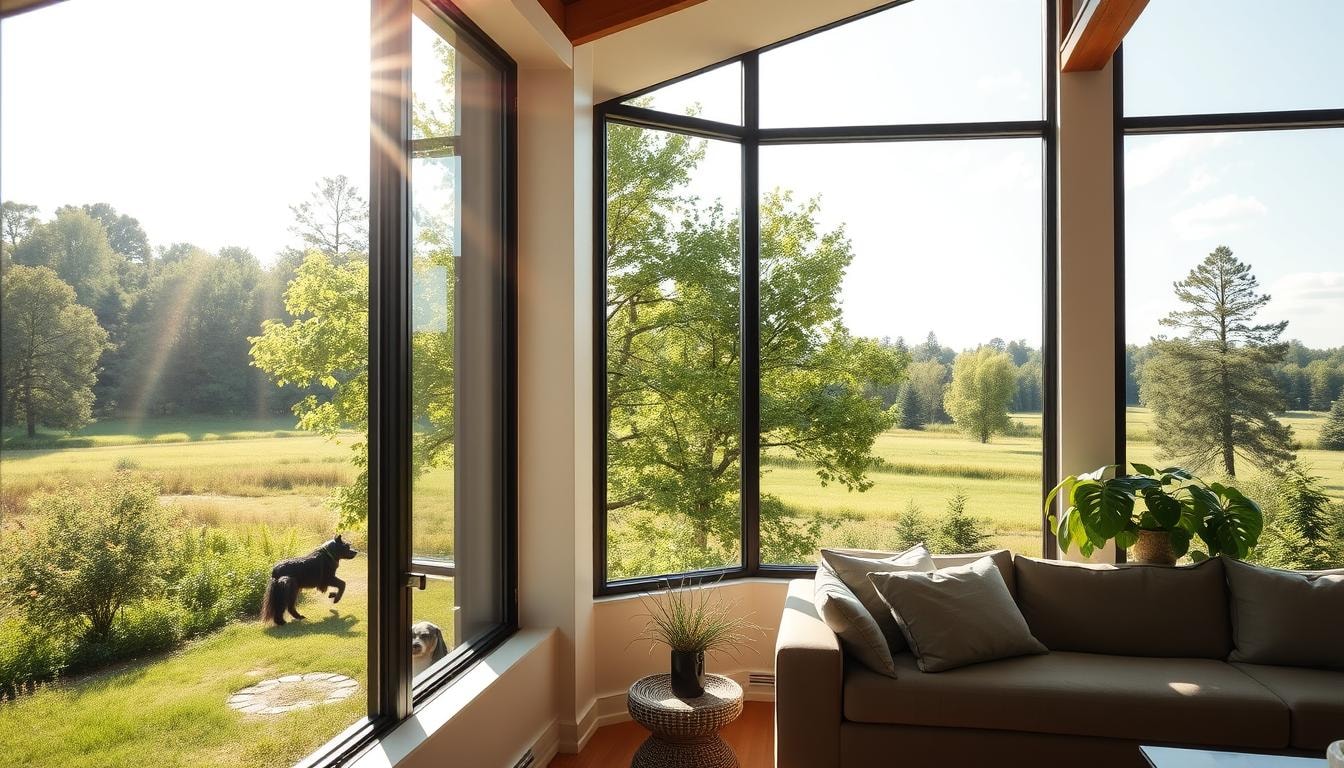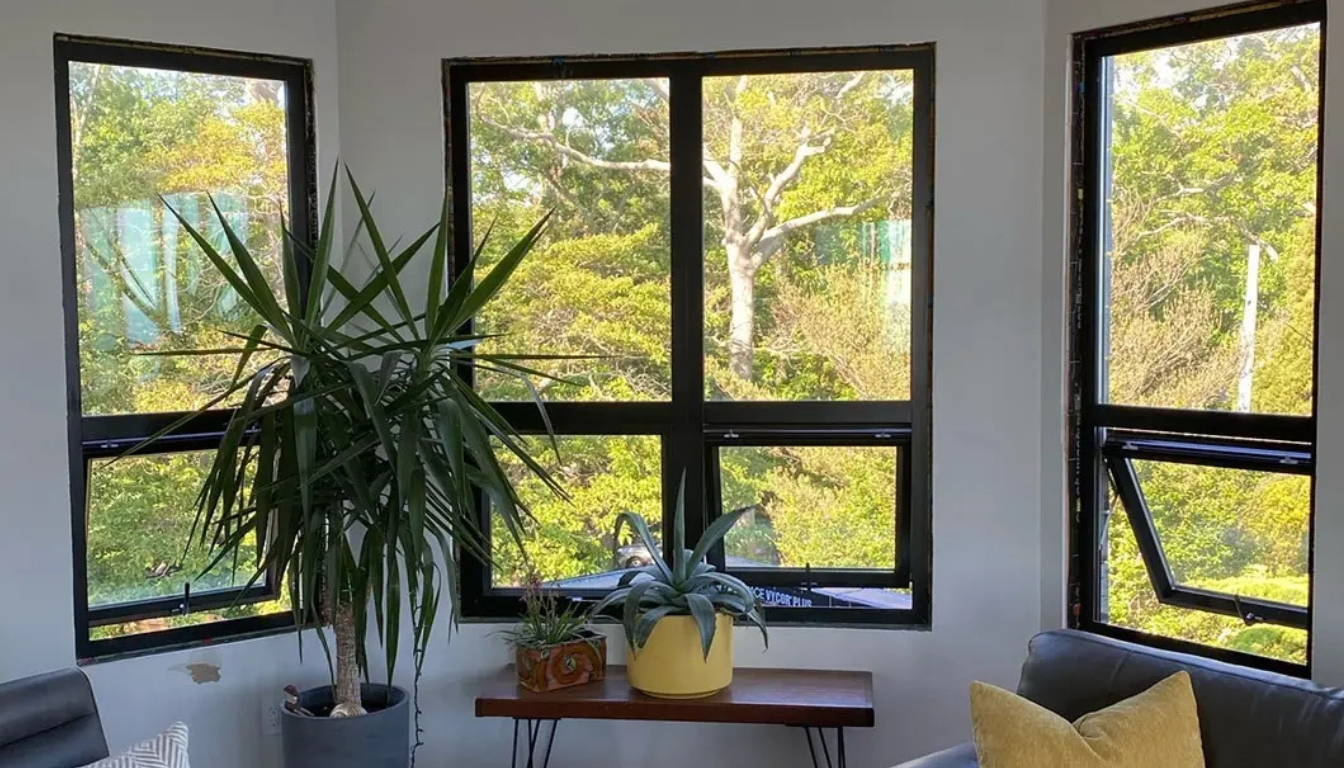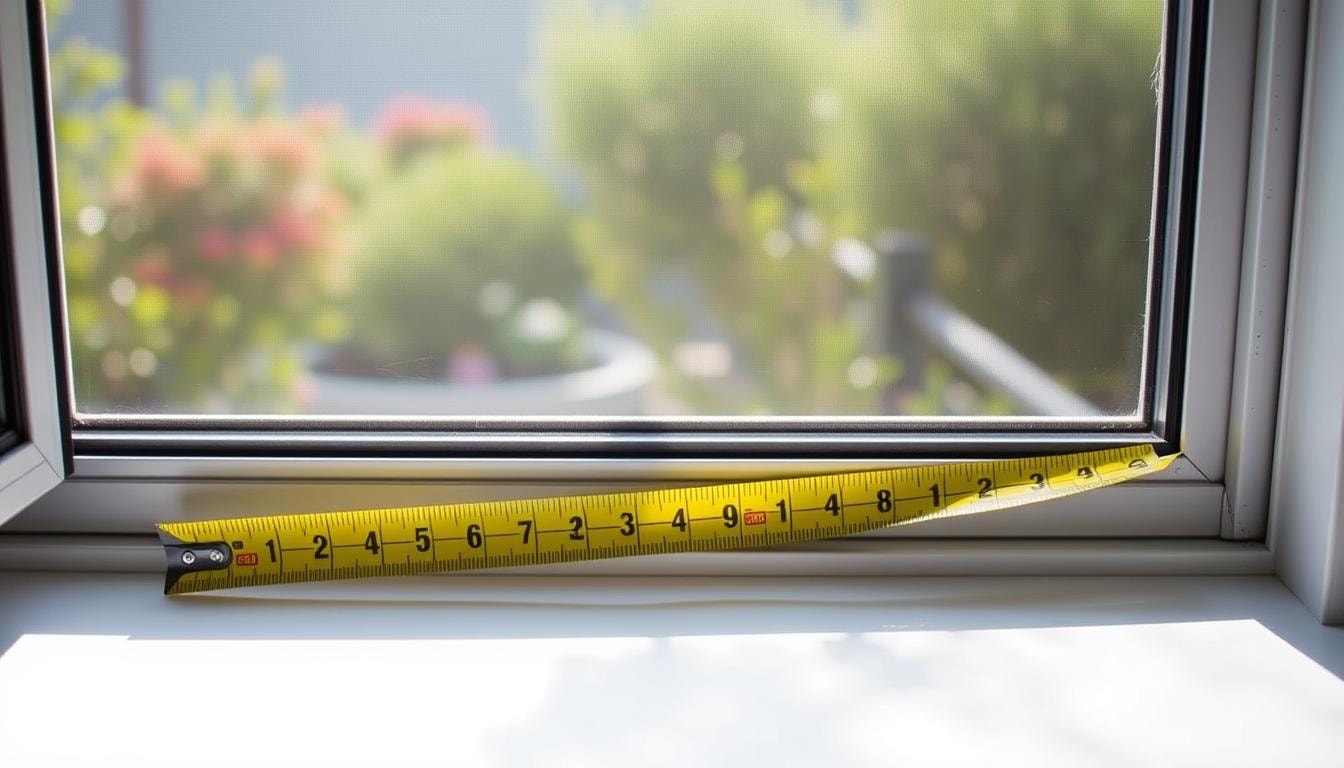
How Do You Measure a Window for a Screen
Getting the right measurements is key for a perfect fit when you replace window screens. This guide will show you how to measure the width, height, and thickness of both screens and windows. We’ll talk about different types of screens, like spring-loaded ones, and why exact measurements are important for a good fit.
Key Takeaways
- Precise measurements are crucial to prevent gaps that allow insects to enter.
- Avoiding common mistakes like not measuring multiple times and ignoring obstructions is essential.
- Window screens enhance security, energy efficiency, and home comfort.
- Essential tools for measuring include a measuring tape, utility knife, and spline roller.
- Screen materials like aluminum, fiberglass, and specialty options are available.
Understanding Window Screen Basics
Window screens are key for any home. They keep insects out and let air in. Knowing how to measure and replace them is important.
There are many types of window screens. Aluminum and fiberglass are two common ones. Each has its own benefits.
Types of Window Screens
- Aluminum window screens are strong and last long. They’re a favorite among homeowners.
- Fiberglass window screens cost less. But they might not last as long as aluminum ones.
Essential Tools for Measuring
Right tools are needed for measuring window screens. You’ll need a measuring tape, utility knife, and spline roller. A long steel measuring tape is best for accurate measurements.
Window Screen Components
A window screen has three main parts: the frame, mesh, and spline. Knowing about these parts helps with a good fit and installation. The frame is usually made of aluminum or vinyl. It holds the screen together.
The mesh is the material that covers the opening. It keeps insects out. The spline is a flexible strip that keeps the mesh in place.
Learning about window screens helps you measure and replace them right. This ensures a strong barrier against the outside.
Different Types of Window Channels
Choosing the right window screen channel is key. Channels can be U-shaped or L-shaped. Each needs its own measurement to fit right.
- U-Channel vs L-Channel Differences: U-shaped channels fit slider windows well. They’re secure and easy to install. L-shaped channels work best in double-hung windows. The screen goes into the frame’s channel.
- Channel Depth and Width Specifications: The depth and width of the channel matter a lot. You need to measure the screen channel carefully. This ensures the new screen fits perfectly without any gaps.
Knowing about different window channels helps you pick the right screens. This ensures they fit your windows perfectly. It makes your windows look and work great.
Measuring Using an Existing Screen Frame
Using an existing window screen frame makes measuring easier. First, take out the screen frame from the window channel. This lets you measure the width and height accurately without any blocks.
Width Measurement Steps
- Measure the screen frame’s width from left to right at the top.
- Measure the screen frame’s width from left to right at the bottom.
- Choose the smaller measurement as the final width.
Height Measurement Steps
- Measure the screen frame’s height from top to bottom on the left side.
- Measure the screen frame’s height from top to bottom on the right side.
- Choose the smaller measurement as the final height.
Frame Thickness Considerations
You also need to think about the screen frame’s thickness. Measure the tracks on the sides and the grooves at the bottom. This info is key for picking the right replacement screen or making sure it fits well in the window channel.
Measuring Windows Without Existing Screens
Measuring windows without screens is easier. You just need a good tape measure. Here’s how to do it:
- Start by putting the tape in the top left corner of the window. Then, stretch it to the right channel to find the width.
- For the height, start at the top left channel and go down to the bottom left channel.
- Always subtract 1/8 inch from both measurements. This is for the screen’s clearance when installed.
- If your window has flat tension springs, subtract another 1/8 inch from the height. This is for the spring’s clearance.
By following these steps, your new window screen will fit perfectly. It will seal well and look great in your home. Getting the measurements right is key for a successful project.
Special Considerations for Slider Windows
Slider windows have a special U-shaped channel design. You need to measure them in a certain way. It’s important to measure the inside of the U-shaped channel for the screen. This ensures the screen fits right.
- U-Shaped Channel Measurements: First, measure the width and height of the U-shaped channel. Make sure to include any lips or obstructions. These measurements help you choose the right screen size. Measuring carefully is key. Any mistake can make the screen not fit right.
- Lip Placement and Adjustments: Also, think about the lips or protrusions in the channel. They can change how the screen fits and slides. You might need to adjust the channel or screen for smooth sliding.
By focusing on slider windows’ unique features, you can get a screen that fits perfectly. Accurate slider window, u shaped channel, and measure correctly measurements are crucial for a good installation.
Measuring for Double-Hung Windows
Measuring double-hung windows needs careful attention. These windows have two parts: an upper and lower sash. Each part must be measured separately for a perfect fit.
First, measure the window’s width at the top, middle, and bottom. Choose the smallest measurement for a snug fit. Then, measure the height at the left, center, and right sides. Pick the smallest measurement for the best fit.
Remember to check for balance systems or jamb liners. These can change the depth needed for your double hung or single hung window screens. Measure the depth at the top, where the lock is, for the minimum depth required.
- Measure the width of the window at the top, middle, and bottom, taking the smallest measurement.
- Measure the height of the window at the left side, center, and right side, taking the smallest measurement.
- Measure the depth of the window at the top, where the lock is located, to ensure the replacement window will fit properly.
- Consider the presence of any balance systems or jamb liners that may affect the overall depth requirement.
By following these steps, you can ensure your new double hung or single hung window screens will fit perfectly. This will give you a secure and efficient solution for your home.
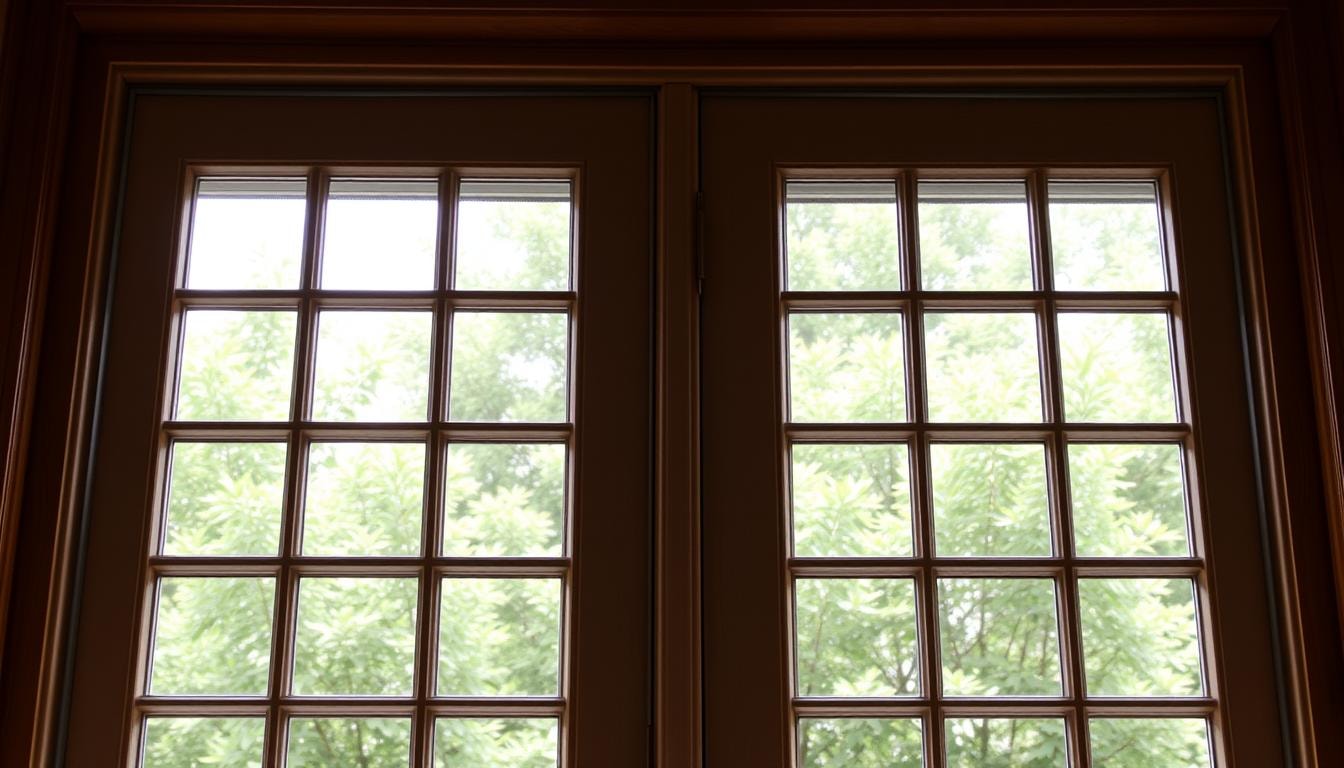
Working with Wood Window Frames
When working with wood window frames, remember to account for stops and weather damage. These can change how the screen fits. You might need to adjust the measurements to get a perfect fit.
- Stop Measurements: Measure the frame’s width and height from stop to stop. Stops are the parts that stick out a bit. They make a space for the screen. Getting these measurements right is key to a screen that fits well.
- Adjustment Calculations: Wood frames can warp or change shape over time. This means you might need to adjust the screen size. Measure the frame’s depth and look for any odd shapes. Then, figure out how much to adjust the screen size.
Understanding wood window frames helps you measure correctly and fit the screen properly in the window frame. This ensures your home gets a secure and effective screen solution.
Common Measuring Mistakes to Avoid
Measuring your windows right is key for a good fit with new screens. But, many people make mistakes that can cost a lot. Knowing these mistakes and taking steps to avoid them helps you measure correctly. This way, you can avoid problems later on.
One big mistake is not checking your measurements several times. You should measure at the top, middle, and bottom for both width and height. Then, use the smallest number. Also, forgetting to add the frame thickness can make screens not fit right.
Many forget to think about things like handles or locks that might get in the way. It’s important to include these in your measurements. This ensures your screen fits perfectly.
- Take at least three width and height measurements, using the smallest for your order
- Carefully measure the depth of the window frame to ensure a snug fit
- Check for any obstructions that could impact the screen’s installation
- Double-check all measurements before placing your order to avoid costly mistakes
By watching out for these common mistakes and measuring well, you can have a smooth installation. You’ll enjoy your screen for many years.
Screen Hardware and Installation Requirements
When measuring for window screens, remember to add space for hardware. This includes pull tabs, plungers, and acorn latches. These parts stick out from the frame. Make sure to include their size in your measurements for a good fit.
Window screen installation needs vary by window type and screen frame. Some screens need extra parts like brick clips to stay in place. Always follow the maker’s guide for a tight and secure screen fit.
Hardware Clearance Adjustments
- Remember to add space for pull tabs, plungers, and acorn latches in your measurements.
- Make sure there’s enough room for these parts to avoid blocking the screen’s installation.
Installation Specifications
- Measure the window frame where you’ll put the screen.
- Cut the screen frame pieces, leaving an extra inch on all sides.
- Trim the mesh around the edges of the frame.
- Put the screen frame together using the pre-notched pieces and corner connectors.
- Push the mesh into the frame’s groove for a tight fit.
- Use extra parts, like brick clips, if needed to hold the screen frame in place.
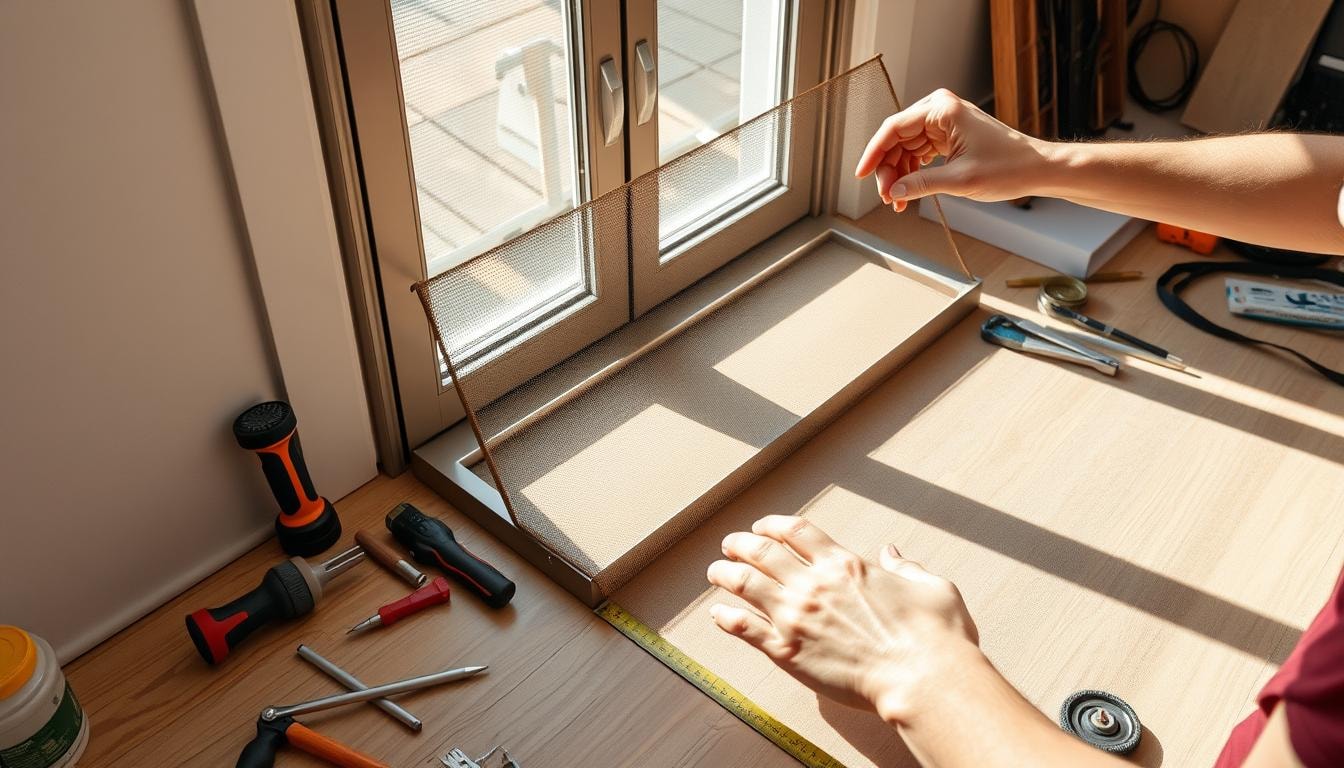
Getting the measurements right and paying attention to hardware space is key for a good screen install. By following the right steps, you’ll get a screen that keeps pests and intruders out.
Get Expert Help from Budget Windows
Don’t risk a poor fit for your new window screens. The team at Budget Windows are experts in ensuring a perfect match, every time. Whether you need to replace an existing screen or measure for an entirely new window, our professionals can guide you through the process. We’ll help you determine the same size requirements, account for any unique features of your other windows, and identify the critical length, shortest side, and longest side measurements needed for a seamless installation. Contact Budget Windows today to speak with our specialists and get the high-quality, properly fitted screens your home deserves.
Conclusion
Measuring window screens right is key for a perfect fit. This improves both function and looks. By using the tips in this guide, you can avoid expensive errors.
This article covers the basics of window screens and how to measure them. It shows how to measure window screens with confidence. Always double-check your measurements and think about any obstructions or hardware.
With the right tools and care, you can get a smooth, pest-free, and energy-saving window screen. Accurate measuring ensures your screens work well for many years.
FAQs
How do I measure the width of a window screen if I have an existing old screen?
To measure the width of an existing screen frame, take measurements at the top and bottom, then use the smaller of the two measurements as the final width.
What if I don’t have an old screen to use as a guide?
If you don’t have an existing screen, simply measure the width of the window from one side channel to the other. Be sure to subtract 1/8 inch from this measurement to allow for clearance when installing the new screen.
How do I determine the height measurement for a window screen?
For the height, measure from the top channel to the bottom channel on the left side, and then on the right side. Use the shorter of the two measurements as the final height.
Do I need to account for anything else when measuring for a replacement window screen?
Yes, be sure to measure the depth of the horizontal screen channel. This will ensure the new screen fits properly in the window frame, especially if there are any obstructions like balance systems or jamb liners.
What if my window frame is made of wood instead of metal?
When working with wood window frames, measure from stop to stop for the width and height. Keep in mind that wood frames can warp over time, so you may need to adjust the screen size slightly to get a perfect fit.





